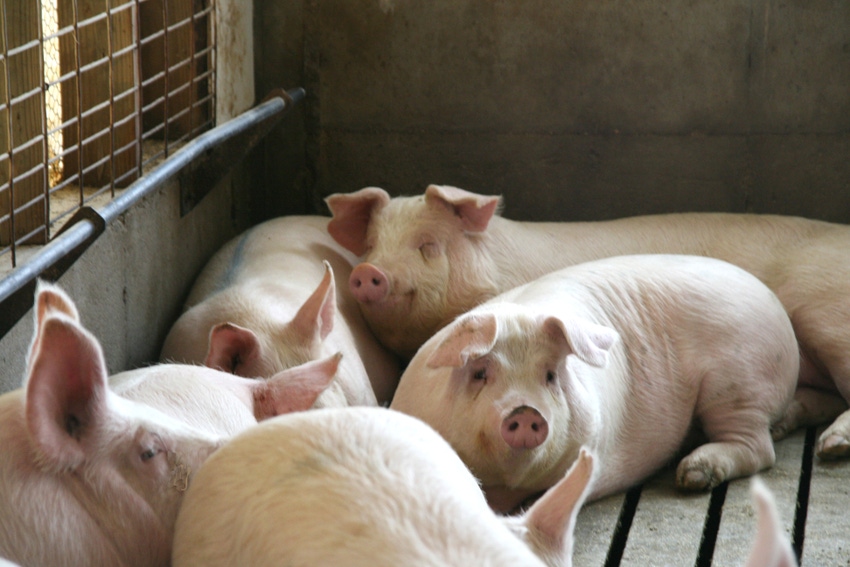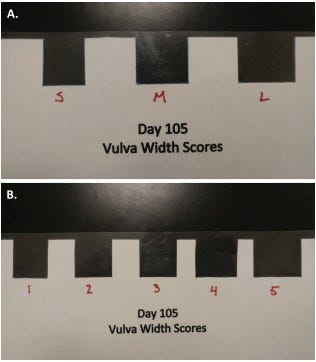Vulva size assessment on gilts and relationship to future productivity
Across all scoring methods, gilts represented in the smallest vulva category produced fewer total born pigs through parity 1 and 2.
January 4, 2022

Selecting replacement gilts for reproductive potential is challenging and often done with low accuracy given the low heritability and environmental influence on associated traits (Serenius and Stalder, 2006). The most predictive selection criteria gilt development unit (GDU) managers can leverage for greater lifetime productivity is identifying gilts that achieve puberty at a younger age (Patterson et al., 2010), however, doing so requires additional labor for proper boar exposure and heat detection to stimulate puberty onset.
During gilt development, the reproductive tract begins to undergo maturation and becomes responsive to circulating hormones several weeks prior to a gilt's first estrus expression (Dyck and Swierstra, 1983; Flowers, 2014). Previous work done at Iowa State concluded that prepubertal vulva size (95-115 days of age) showed to have potential value as a marker for gilts with respect to their reproductive tract development and ability to reach puberty by 180 days of age (Graves et al., 2019). Collectively, these findings led to implementing a vulva size scoring system in a commercial production setting, with the hypothesis that assessing a gilt's vulva width (VW) at 15 weeks of age would effectively distinguish gilts with different reproductive potential.
This study was done in collaboration with a commercial integrator in southeast Iowa, where 731 gilts were individually evaluated for vulva development at 15 weeks of age and subsequently analyzed for the effects on retention rate and farrowing performance to parity 2.
Vulva scores were assigned for each gilt using three different scoring methods.
Vulva Score Method A (VSA) used a three-score strategy designed using previous data (Graves et al., 2019) where gilts were stratified into the following categories; Small (S; VW < 27 mm), Medium (M; VW 27 to 34 mm) and Large (L; VW > 34 mm).
Vulva Score Method B (VSB) used a similar tool to categorize gilts into five groups based on VW: 1 (VW < 27 mm), 2 (VW 27 to 29 mm), 3 (VW 29 to 31 mm), 4 (VW 31 to 33 mm) and 5 (VW > 33 mm). The design of the tool used for VSA and VSB was a laminated card with precisely sized series of sections removed to accurately assign a vulva score based on the described dimensions (Figure 1).
Farm Score (FS) was a visual, subjective assessment of vulva size (conducted visually by trained farm staff) which stratified gilts into three categories (1, 2 or 3), where score 1 intended to identify gilts whose vulva size represented the bottom 15%, a score 2 was considered intermediate and represented the middle 70%, and a score 3 was intended to represent the 15% of gilts with the largest vulvas.

Following initial vulva evaluation, gilts were transported to two separate sow farms that were included in the GDU production flow. Both farms recorded production data, which was later merged with the prepubertal vulva size corresponding to each sow.
Vulva scoring and the impact on gilts reaching parity 1
Across all vulva scoring methods (VSA, VSB, FS), gilts scored in the lowest respective category (S, VSA; 1, VSB; 1, FS) had a lower likelihood of reaching parity 1 (Figure 2). No differences were detected in retention from parity 1 to parity 2 (data not shown).

Vulva scoring and the impact on P1 and P2 performance
Vulva Score Method A
When evaluating the affect of VSA on total born, gilts with vulvas scored as small (S) had decreased litter size compared to gilts scored as medium (M), as well as compared to the average total born of all gilts scored Medium and Large (M+L) across parity 1, parity 2 and lifetime pigs produced (P1+P2). Similar differences were observed for piglets born alive for P2 and lifetime born alive (P1+P2; Table 1).

Vulva Score Method B
Parity 1 total born for gilts with a vulva score of 1 was lower compared to those with a vulva score 3 and 4. Additionally, gilts with a score of 1 had .9 fewer total born compared to the remaining gilts scored 2-5. Similarly for parity 2, gilts scoring a 1 had fewer total born and born alive when compared to the average of the gilts scoring 2-5. When evaluating litter performance for P1+P2, gilts with a score of 1 produced 2.36 fewer pigs compared to the remaining gilts scored 2-5, and had 1.91 fewer pigs born alive when compared to scores 2-5 (Table 2).
Farm Score Method
When evaluating using the Farm Score method, no differences were detected through parity 1. Parity 2 showed a tendency for increased total born and born alive, and when evaluated for total pigs produced through parity 2 (P1+P2) gilts scoring 1 tended to have reduced total born compared to the remaining gilts scored 2-3 (Table 3).
Summary
Identifying gilts best suited for the breeding herd is challenging and results can be highly variable. Across many phenotypic traits to be evaluated, reproductive ability is the highest value trait although is very difficult to assess prior to any reproductive events in the female's life. The results from this study showed that assessing gilts based on prepubertal vulva size could effectively distinguish those less likely to reach parity 1 and have fewer lifetime pigs through parity 2. Therefore, vulva development may be a potential selection criterion that can be included to separate the bottom portion of a gilt pool likely to be reproductively inferior compared to their cohorts.
Key Take Home Points
Previous research has shown that gilts average or above for vulva size were more likely to reach puberty by 180 days of age (Graves et al. 2019).
Across all scoring methods, gilts represented in the smallest vulva category were less likely to reach parity 1.
Across all scoring methods, gilts represented in the smallest vulva category produced fewer total born pigs through parity 1 and 2. VSA and VSB methods showed reduced born alive over two parities for gilts in the smallest vulva category compared to the remaining gilts scored.
For additional information on the current study see published work:
Matthew R Romoser, Benjamin J Hale, Jacob T Seibert, Tom Gall, Christopher J Rademacher, Kenneth J Stalder, Lance H Baumgard, Aileen F Keating, Jason W Ross, Methods for reproductive tract scoring as a tool for improving sow productivity, Translational Animal Science, Volume 4, Issue 1, January 2020, Pages 275–284, https://doi.org/10.1093/tas/txz160
References
Dyck, G. W., and E. E. Swierstra. 1983. Growth of the reproductive tract of the gilt from birth to puberty. Can. J. Anim. Sci. 63(1):81-87.
Flowers, W.L., Evaluation of a Physiological Test for Sow Longevity. 2014. NPB #11-103.
Graves, K. L., B. R. Mordhorst, E. C. Wright, B. J. Hale, K. J. Stalder, A. F. Keating, and J. W. Ross. 2019. Identification of measures predictive of age of puberty onset in gilts. Transl. Anim. Sci. 4(1):285–292. doi:10.1093/tas/txz173.
Patterson, J. L., E. Beltranena, and G. R. Foxcroft. 2010. The effect of gilt age at first estrus and breeding on third estrus on sow body weight changes and long-term reproductive performance. J. Anim. Sci. 88(7):2500-2513.
Serenius, T., And K. J. Stalder. 2006. Selection For Sow Longevity. Journal Of Animal Science 84 Suppl:E166-171. (; Research Support, Non-U.S. Gov't; Research Support, U.S. Gov't, Non-P.H.S.; Review)
Sources: Matt Romoser and Jason Ross, who are solely responsible for the information provided, and wholly own the information. Informa Business Media and all its subsidiaries are not responsible for any of the content contained in this information asset.
You May Also Like



